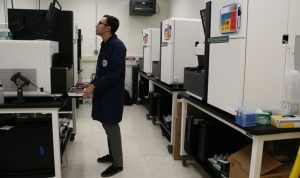 A couple of recent announcements in the next-generation sequencing (NGS) market got our attention as strong signs that both technology and applications are rapidly diversifying within that arena. It’s continued evidence that the NGS market is not only expanding rapidly, but also that there are no limits in sight to the demand for genomic information.
A couple of recent announcements in the next-generation sequencing (NGS) market got our attention as strong signs that both technology and applications are rapidly diversifying within that arena. It’s continued evidence that the NGS market is not only expanding rapidly, but also that there are no limits in sight to the demand for genomic information.
For years, Illumina had something of a stranglehold on the NGS market. Its sequencing-by-synthesis platforms run the gamut from low to high throughput, with a broad range of price points that have made them accessible to virtually any lab or institution. Other players have come and gone, but none of those vendors ever made a noticeable dent in Illumina’s enormous market share. So it was extremely interesting to see Illumina’s recent announcement that it would acquire sequencing company Pacific Biosciences, better known as PacBio, for $1.2 billion. It’s the largest such deal that Illumina has made since it bought the original NGS technology that launched the company into this field.
In an investor call following the announcement, the CEOs of Illumina and PacBio made the case that their technologies serve different needs and are therefore complementary. If you don’t follow the NGS market, here’s the quick explanation: Illumina sequencers churn out a prodigious amount of DNA data, but in very short snippets. PacBio sequencers generate extraordinarily long stretches of DNA information, but at lower capacity. These short reads and long reads are used for different scientific or translational applications; in fact, for many projects, researchers combine the two data sets for a more accurate and comprehensive view of the genome than either technology can provide alone.
Illumina’s appetite for bringing this complementary technology in-house is a strong indicator that the company believes there is opportunity for significant growth across sequencing applications for which its own short-read technology is not sufficient. This should help allay any concerns on the investor side that the sequencing market might be approaching any kind of saturation point.
The other announcement of interest came from QIAGEN, a leading life science company based in Germany, which launched new products for targeted cancer sequencing. Worth noting: while QIAGEN markets its own NGS platform, the GeneReader, its targeted sequencing panels are designed to be used with any vendor’s sequencing system. These new panels have a clinical bent, with their focus on breast, ovarian, and other cancers. Clearly, QIAGEN sees strong demand for sequencing among both clinical users and developers of companion diagnostics, further validation that NGS instruments and genomic data have spread far beyond their origin in basic research labs.
It’s been 15 years since the very first sequence of a human genome was declared complete. In a remarkably short period, the sequencing market has grown from its roots in a handful of specialized genomic laboratories to a sky-is-the-limit role in science and medicine. We believe that the recent announcements from Illumina and QIAGEN, along with so many other supporting events, offer compelling evidence that the NGS field will continue growing at a brisk pace to address both new and existing needs.